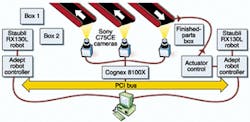Robots and vision system automate bearing assembly
Andrew Wilson,Editor,[email protected]
FAG Automotive (Schweinfurt, Germany), a wholly owned subsidiary of FAG Kugelfischer Georg Schafer AG, manufactures wheel mounts and bearing assemblies for Audi A6 and Volkswagen automobiles. In the production of these assemblies, individual wheel mounts and bearing assemblies are delivered to the factory separately and must be placed on automated production lines for further assembly.
In the past, such assembly processes were implemented manually, with operators unloading parts from boxes and placing them on conveyors for delivery to an automated assembly station. Tedious and repetitive manual work is a prime target for automated machine-vision and robotics systems. Realizing this, Karl Bywalez, a project manager with FAG, enlisted Grude Systeme GmbH (Sauerlach, Germany) to automate the process using off-the-shelf cameras, frame grabbers, robots, and robot controllers.
At FAG, individual bearing assemblies in several prepacked boxes are delivered to the robotic placement system by a forklift truck. These boxes must be unpacked and each bearing component lifted from the box and placed on a conveyor belt. Like the bearing components, unsorted wheel mounts in unpacked randomly oriented trays are also delivered by a forklift truck. During assembly operation, these components are placed on a second conveyor belt, where they are transported along with the bearings to the assembly station. After assembly, finished wheel-mount and bearing assemblies are returned on a third conveyor belt to the shipping station. There, the assemblies are picked and placed into cartons for final shipping.
To automate this manufacturing process, Grude Systeme developed a PC-based system using two robots and a multicamera machine-vision system. To properly place the bearing components from the prepacked boxes onto the conveyor, a C75CE CCD camera from Sony (Park Ridge, NJ) captures images of a number of parts. Next, the images are digitized using a Series 8100 frame grabber and PatMax software from Cognex Corp. (Natick, MA).
"Using Cognex's PatMax software, two bearing components are first localized and their real-world coordinate transforms calculated," says Stefan Angebauer, managing director of Grude Systeme. These coordinates are then transmitted over the RS-232 port of the PC to an Adept Technologies Inc. (Cincinnati, OH) robot controller that directs an RX130L robot from Staubli (Faverges, Switzerland). The robot then picks the two bearing components and places them on a conveyor belt.
Unlike the bearing components, the randomly oriented wheel mounts are located in trays within the workcell. To place these parts on the second conveyor belt, another Sony C75CE camera captures images of the wheel mounts that are also interfaced to the Cognex Series 8100 frame-grabber board. To speed the pick-and-place process, the Cognex PatMax software locates two different mounts in the left- and right-hand side of the tray. Both images are then compared and best-fit image co-ordinates are used by the Adept controller to command the Staubli RX130L robot to pick and place the part on the conveyor belt.
After both parts are placed on the two conveyor belts and sent to another workcell for assembly, they are returned as finished parts on a third conveyor belt. After the finished parts arrive, a magnetic actuator triggers another Adept robot controller that a finished part is ready for picking by a second Staubli robot. To properly place the finished part in its shipping container, a third Sony C75CE camera images the blister package in the box. Once again, PatMax software identifies the blister package and transfers the "real-world" coordinates to the robot controller. The second Staubli robot then picks the finished part and places it in the box for shipping.

